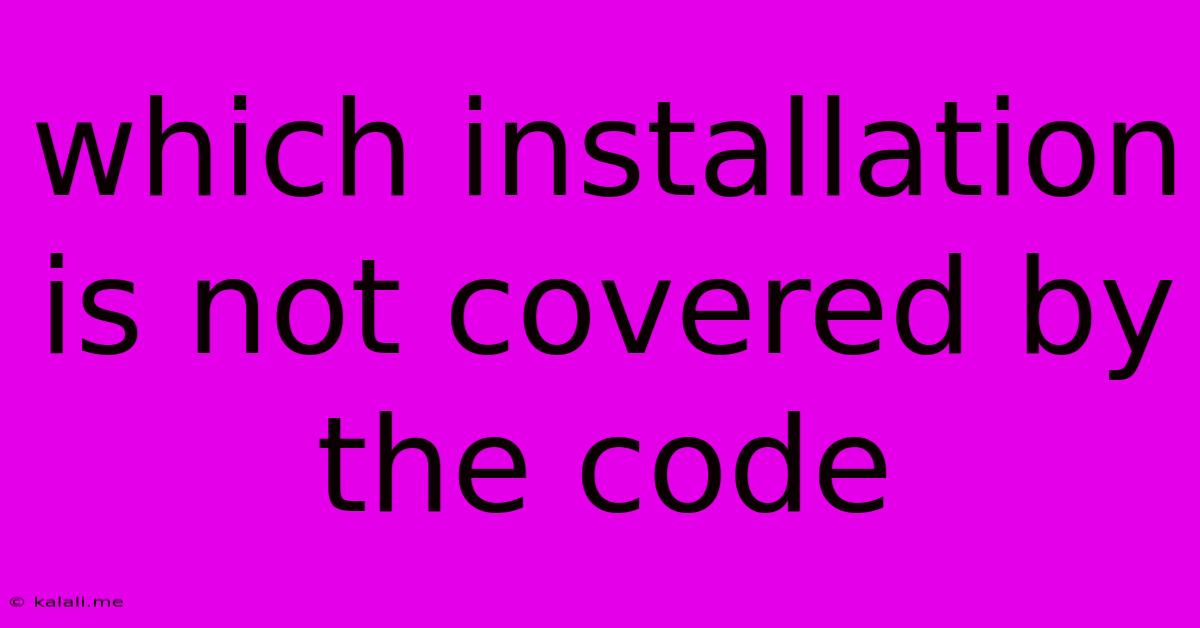Which Installation Is Not Covered By The Code
Kalali
Jun 13, 2025 · 4 min read

Table of Contents
Which Installation Is Not Covered by the Code? A Comprehensive Guide
This article delves into the crucial question of code coverage and what installations might fall outside its protective umbrella. Understanding this is vital for ensuring software stability, security, and preventing costly errors. We'll explore various scenarios where code might not be adequately covered, focusing on practical examples and solutions. This is essential for developers aiming for robust and reliable software deployments.
What is Code Coverage?
Before we dive into uncovered installations, let's clarify what code coverage means. Code coverage is a metric that measures the amount of code executed during testing. High code coverage suggests a more thorough testing process, indicating a lower likelihood of undiscovered bugs. However, achieving 100% code coverage doesn't guarantee a bug-free application; it simply means all lines of code have been executed at some point during testing.
Scenarios of Uncovered Installations:
Several scenarios can lead to installations not being covered by existing code tests:
1. Unique Hardware/Software Configurations:
- The Problem: Testing typically occurs in a controlled environment. A user's unique hardware combination (CPU, RAM, GPU, specific peripherals), operating system version, or other software dependencies might interact unexpectedly with your application. These unforeseen interactions might not be replicated in your testing phase, leaving these specific installations uncovered.
- Example: Your application relies on a specific graphics library. Your testing is done on a high-end graphics card. A user with an older, less powerful card experiences crashes or glitches not encountered during development testing.
- Solution: Utilize virtual machines (VMs) or containers to simulate diverse hardware and software configurations during testing. Consider employing a wider range of hardware and software in your testing environment, or leverage crowdsourced testing platforms to get feedback from users with varied setups.
2. Edge Cases and Unusual User Behavior:
- The Problem: Test cases often focus on common user flows and typical data inputs. However, users can be unpredictable and might interact with the software in unexpected ways, leading to edge cases that weren't considered during testing. This often exposes gaps in code coverage.
- Example: Your application handles file uploads. Your tests cover typical file sizes and formats. A user attempts to upload an extremely large file or an unsupported file type, causing the application to crash.
- Solution: Develop robust error handling and input validation. Design your tests to include edge cases, such as boundary conditions, invalid inputs, and extreme values. Use fuzz testing to introduce random, unexpected inputs into your system to uncover potential vulnerabilities.
3. Third-Party Libraries and Dependencies:
- The Problem: Many applications rely on third-party libraries. While you test your own code, you might not thoroughly test the interactions between your code and these external dependencies. Bugs or vulnerabilities within these libraries can cause issues in certain installations without being reflected in your own code coverage metrics.
- Example: You use a payment gateway library. A vulnerability in the library allows attackers to compromise user data on specific installations due to a configuration issue, while your code’s testing remains unaffected.
- Solution: Carefully vet third-party libraries. Check for updated versions, security patches, and community feedback. Where possible, incorporate tests that interact with these external libraries to help identify potential points of failure in the integration.
4. Race Conditions and Concurrency Issues:**
- The Problem: Concurrency issues, like race conditions, are notoriously difficult to reproduce consistently. They arise when multiple threads or processes access and modify shared resources simultaneously, leading to unpredictable behavior. These often only manifest in specific scenarios and installations.
- Example: Your application handles multiple simultaneous database connections. A race condition only occurs under high load on a particular server configuration, leading to data corruption.
- Solution: Use appropriate synchronization mechanisms (locks, mutexes, semaphores) to control access to shared resources. Employ tools and techniques designed to detect and diagnose concurrency problems, including load testing and specialized debugging tools.
Conclusion:
While striving for high code coverage is crucial, it’s vital to remember that it’s not a silver bullet. Understanding the potential blind spots—unique hardware/software configurations, edge cases, third-party libraries, and concurrency issues—is key to building truly robust and reliable software. By proactively addressing these areas during the development and testing process, you can significantly reduce the risk of encountering unexpected problems in various installations and improve the overall user experience.
Latest Posts
Latest Posts
-
Four Bells Toll Together At 9am
Jun 14, 2025
-
Identify A True Statement About Theories
Jun 14, 2025
-
Which Of The Following Is True Of Voip
Jun 14, 2025
-
Branch Of Medicine Concerned With Digestive Diseases
Jun 14, 2025
-
112 Is 56 Of What Number
Jun 14, 2025
Related Post
Thank you for visiting our website which covers about Which Installation Is Not Covered By The Code . We hope the information provided has been useful to you. Feel free to contact us if you have any questions or need further assistance. See you next time and don't miss to bookmark.